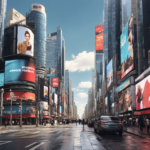Okay, so Starbucks is basically the king of coffee, right? They’ve got stores everywhere, and we all know that green mermaid logo. But how did they get to be so big and successful? Well, a big part of it is their supply chain magic.
You see, Starbucks decided to do something kinda crazy: they took control of almost every step of the coffee-making process. From growing the beans to roasting them and finally serving you that fancy latte, they wanted to be in charge. This is called vertical integration, and it’s like running a one-stop coffee shop empire.
But, let’s be real, running an empire isn’t all rainbows and unicorns. Starbucks had to deal with some serious headaches along the way. We’re talking about supply chain nightmares, crazy costs, and even ethical dilemmas. It wasn’t all pumpkin spice lattes and comfy chairs, folks. So, what can small business owners learn from its rollercoaster ride?
Let’s uncover how Starbucks transformed potential pitfalls into profit opportunities, and show you how to do the same to supercharge your own business.
It’s Not All Sunshine and Caramel Drizzle: Starbucks’ Challenges in Supply Chain Management

Delivery and Logistics Issues
Making sure customers get their orders on time is a big deal for keeping them happy. Late deliveries can lead to unhappy customers, lost sales, and a hit to the brand’s rep.
Starbucks has been teaming up with food delivery platforms to widen its reach and make things more convenient for customers.
Uber Eats:
Starbucks kicked off its delivery journey with Uber Eats back in 2018. They started with a pilot program in Miami and quickly expanded to 11 markets across the U.S. This partnership has been a game-changer for Starbucks, allowing them to reach more customers without needing to open new stores, with customers ordering Starbucks products through the Uber Eats app.
DoorDash:
In 2023, Starbucks added DoorDash to its delivery lineup, giving it more options than relying on a single partner. This new partnership expanded Starbucks’ reach even further, starting with tests in cities like Atlanta, Sacramento, and Houston.
Grubhub:
In some regions, Starbucks collaborates with Grubhub to provide delivery services. Grubhub is a big player in the delivery game, and Starbucks adding them to its list of delivery partners boosted sales because it was able to tap into GrubHub’s vast customer base.
Starbucks also collaborated with major logistics companies to streamline its supply chain behind the scenes.
It partnered with DHL to manage logistics operations in the UK, while in the United States, Starbucks has worked with Schneider National for logistics solutions, particularly in the transportation of goods. Schneider’s expertise in trucking and logistics helps Starbucks manage its extensive network of distribution centers and stores.
These partnerships highlight Starbucks’ business strategy to integrate with both consumer-facing delivery services and logistics experts to improve efficiency, reduce delivery times, and expand their market reach.
So, if you’re a small business owner or a solo hustler trying to make your mark, take a page out of Starbucks’ playbook. Collaborate with established delivery services—it’s like having a wingman to help you reach a wider audience without all the headaches of managing logistics yourself.
And remember, variety is the spice of life (and business). Having multiple delivery partners can help you adapt to those pesky market changes and customer preferences like a pro.
Spending Spree Gone Wrong: Overexpansion and Overspending
Starbucks went a little crazy with the whole “let’s own all the coffee shops” thing. They were like, “Franchises? Nah, we got this!” So instead of letting other people run their stores, they decided to keep them all under their own green mermaid-themed roof.
Now, you might be thinking, “But wait, doesn’t that mean they have to pay for everything themselves?” Bingo! That’s exactly what happened. Starbucks ended up spending a ton of money to make sure their stores were the best of the best, with top-notch service, amazing products, and an overall experience that would make you want to move in and never leave.
But here’s the thing – all that money spent on making their stores perfect also led to some major inefficiencies. It was like trying to juggle a million coffee beans at once. They just couldn’t keep up!
Now, if you’re a small business owner, you might be thinking, “Well, I don’t have a billion dollars to spend on acquisitions and stuff.” And you know what? That’s probably a good thing. Starbucks learned the hard way that trying to expand too fast and own everything can lead to some serious headaches.
So, if you’re feeling the urge to take over the world (or at least your local market), slow your roll, my friend. Focus on sustainable growth instead of biting off more than you can chew. Trust me, your bank account will thank you.
New Products, New Losses: Starbucks’ Misadventures Beyond Coffee
Starbucks tried introducing new products into their supply through acquisitions and this is how they failed:
Alright, so Starbucks was like, “Hey, we’re the king of coffee, but what about all those tea lovers out there?” So in 2012, they decided to acquire Teavana, a specialty tea retailer, thinking they could cash in on the tea craze. It was like Starbucks was saying, “I’ll have a venti tea latte with that acquisition, please!”
At first, things were looking good. The Teavana-branded tea drinks were raking in nearly a billion bucks in sales at Starbucks stores across the U.S. But then, it was like the tea just stopped selling. What happened? Well, turns out many Teavana stores were in malls, and we all know how that story ends.
With online shopping taking over and people just not feeling the mall vibe anymore, Teavana stores were struggling to meet their sales goals. It was like trying to sell ice to an eskimo in the middle of summer.
Starbucks realized they had to focus on what they did best – coffee. So they decided to close down the Teavana stores and put their energy into their core business and digital initiatives instead. It was like a bad breakup, but sometimes you gotta let go of the tea to keep the coffee flowing.
But Teavana wasn’t the only acquisition that left Starbucks with a bad taste in their mouth. In 2011, they bought Evolution Fresh, thinking they could cash in on the health and wellness craze by offering premium juices and smoothies. But it turned out to be more like a bad case of indigestion.
There were a few reasons why Evolution Fresh just didn’t work out:
- The juice market, while promising, was a drop in the bucket compared to the massive coffee industry. It was like trying to fill a kiddie pool with a fire hydrant.
- Integrating Evolution Fresh into Starbucks’ complex supply chain was like trying to fit a square peg in a round hole. It just didn’t work.
- Starbucks’ focus kept drifting back to coffee, leaving poor Evolution Fresh out in the cold.
- The juice market got crowded faster than a barista on a Monday morning. With new players popping up left and right, Evolution Fresh just couldn’t stand out.
So in 2022, Starbucks decided to pass the smoothie shaker to Bolthouse Farms and call it a day. They realized partnerships are the way to go – more efficient, cost-effective, and let them focus on what they do best: slinging coffee.
Moral of the story? Sometimes you gotta stick to your specialty, even if it’s tempting to branch out. Starbucks learned the hard way that not every acquisition is a grande idea. But hey, at least they had their coffee to fall back on!
Ethical and Sustainability Issues
Starbucks has found itself in the hot seat lately, facing some serious side-eye over its ethical sourcing practices. As a global coffee giant, they have a big impact on the lives of farmers in coffee-producing countries, and let’s just say, not all the news has been good.
To tackle these concerns head-on and show they care about social responsibility, Starbucks has rolled out a bunch of initiatives that resonate with consumers who want to sip their lattes guilt-free.
Farmer Support Centers (FSCs)
So, what’s the deal? Well, accusations of underpaying farmers and contributing to unfair trade practices have put a bit of a cloud over Starbucks’ reputation. Making sure coffee farmers get fair wages and decent working conditions can be a real challenge, especially in places where labor standards are about as high as a toddler’s attention span. To help, Starbucks set up Farmer Support Centers (FSCs) in major coffee-growing regions like Costa Rica, Rwanda, Tanzania, Colombia, China, and Ethiopia.
Objectives and Impact:
- Technical Assistance: The FSCs offer farmers access to agronomists and experts who provide hands-on support and training. This includes advice on sustainable farming practices, improving crop quality, and increasing yields. In Rwanda, Starbucks’ FSC has worked with local farmers to introduce new coffee varieties that are more resistant to disease and have higher yields.
- Sustainability Practices: The centers promote sustainable agricultural practices to help reduce their environmental impact. Techniques such as water conservation, soil health management, and shade-grown coffee are emphasized. The FSC in Costa Rica has implemented programs to reduce the use of pesticides and promote organic farming techniques.
- Economic Viability: The support provided by FSCs helps farmers become more economically viable because improving the quality and yield of their coffee crops gives them better prices and more stable incomes.
The Global Farmer Fund
Launched in 2014, the Global Farmer Fund is a $50 million commitment by Starbucks to provide financing to coffee farmers. This fund aims to help farmers manage the volatility of coffee prices and invest in the long-term sustainability of their farms.
The Global Farmer Fund offers farmers access to affordable loans, enabling them to invest in their farms. This can include purchasing new equipment, expanding operations, or transitioning to more sustainable practices.
Loans from the Global Farmer Fund can be used for sustainability projects, such as replanting coffee trees, installing irrigation systems, or adopting eco-friendly farming practices.
In Colombia, loans from the Global Farmer Fund have enabled farmers to renovate aging coffee plantations, improving productivity and quality.
In Tanzania, the fund has supported farmers in adopting climate-smart agriculture techniques to cope with changing weather patterns.
These initiatives are a demonstration of Starbucks’ commitment to social responsibility because the efforts not only help mitigate negative publicity but also resonate with a growing consumer base that prioritizes ethical consumption.
Fair Trade Certification and C.A.F.E. Practices:
Starbucks offers a range of Fair Trade-certified coffees, ensuring that farmers receive fair prices and that the coffee is produced under environmentally sustainable and socially responsible conditions. This certification is part of Starbucks’ broader commitment to ethical sourcing.
It also developed its Coffee and Farmer Equity (C.A.F.E.) Practices program to ensure ethical sourcing. This program evaluates the economic, social, and environmental aspects of coffee production. Farms are assessed against these standards to ensure they meet Starbucks’ criteria for ethical sourcing.
According to these standards:
- Suppliers have to show proof of payments made for coffee beans, ensuring farmers get their fair share. This transparency allows Starbucks to track the origins of its coffee and the prices paid to farmers.
- The program mandates that farmers protect the rights of workers, ensuring safe and fair working conditions. This includes paying at least the minimum legal wage and prohibiting child labor.
- C.A.F.E. Practices promote sustainable agricultural practices, such as conserving water and biodiversity and maintaining shade trees to combat climate change.
- All coffee sourced must meet high-quality standards, with Starbucks paying premiums for ethically sourced coffee that meets these criteria. This premium pricing helps support farmer profitability.
Starbucks’ commitment to ethical sourcing through C.A.F.E. Practices and Coffee Sourcing Guidelines (CSG) has resulted in long-term savings and improved brand reputation, as reported by the Ethical Consumer Research Association.
Keep Your Image Sparkling and Green: Brand Reputation
Alright, let’s talk about how Starbucks is trying to keep that green mermaid logo sparkling clean. You know, making sure their brand doesn’t end up in the mud because of environmental issues. They’re on a mission to align themselves with those eco-conscious customers who want to feel good about their coffee habits. In fact, Starbucks is expanding its plant-based food and beverage options to cater to changing consumer preferences and promote sustainability.
They’ve announced a brand new $130 million Coffee Innovation Park in China. It’s like a sustainability theme park for coffee lovers! This place is decked out with all the latest energy and water efficiency tech, and it’s aiming for the gold standard in green building – LEED Platinum and China’s Three Star Green Building certifications. Talk about putting their money where their mouth is when it comes to ethical sourcing and being kind to Mother Earth.
In 2024, Starbucks announced a new initiative to reduce waste by implementing reusable cups, aiming to increase sustainability and improve its brand image.
Starbucks reusable cups
And let’s not forget about their new eco-friendly packaging line, which hit shelves in 2023. These babies are made from recycled materials, and let’s just say, environmentally-conscious coffee drinkers are loving it. It’s like Starbucks is giving them a high-five every time they take a sip.
So, what’s the takeaway for small businesses? Well, it’s all about building that brand reputation and keeping it shiny. Pay attention to those ethical issues, because, let’s be real, no one wants to be known as the company that’s wrecking the planet; which means that being focused on sustainability and sourcing responsibly can boost customer loyalty and increase sales.
Transparency is Trendy:
These days, consumers don’t just want a cup of coffee—they want to know the whole story behind it. Where did those beans come from? Who grew them? Did the farmers get a fair share?
Starbucks has been all over this ethical sourcing thing, and it’s been a big hit with their customers. By shining a light on every step of their supply chain, they’re building trust and loyalty like nobody’s business.
In 2018, Starbucks launched a pilot program using blockchain technology to trace coffee beans from Costa Rica, Colombia, and Rwanda. This provides insights into the origins of coffee and the company’s efforts to support farmers. This digital traceability not only empowers farmers with valuable information about where their beans go but also strengthens the connection between consumers and the people behind their coffee.
This helps to increase transparency from “bean to cup” as part of the company’s commitment to sustainable and ethically sourced coffee beans.
Supply Chain Improvement and Efficiency
Investing in research and development helps Starbucks to refine its sourcing methods and ensure that its coffee is both high-quality and environmentally responsible.
These strategies have allowed Starbucks to secure its supply chain, improve product quality, and promote sustainability, ultimately contributing to the company’s success and reputation in the coffee industry.
Starbucks’ partnership with Azure for cloud-based AI tools has improved their supply chain efficiency by 20%. This has revolutionized the customer experience by integrating advanced technologies, from cloud computing to blockchain, in collaboration with Microsoft.
By utilizing reinforcement learning, Starbucks’ mobile app provides personalized order suggestions based on a variety of factors, such as local store inventory, weather, and previous orders, ensuring customers receive tailored recommendations.
Starbucks employs the Internet of Things (IoT) to maintain its equipment efficiently, using Azure Sphere to secure and monitor devices, thereby reducing downtime and ensuring consistent product quality.
Takeaways for Small Business Owners
If you want to tackle your small business supply chain issues like a pro, take a page out of Starbucks’ playbook.
Collaboration is key:
First off, Starbucks didn’t go it alone—they teamed up with established partners.
Starbucks expanded its delivery capabilities by partnering with multiple delivery services. This diversification not only broadened their market reach but also mitigated risks associated with relying on a single delivery partner. This shows small businesses can similarly benefit from forming strategic partnerships to enhance their distribution networks and improve customer service without the overhead of managing logistics independently.
Tech is Your Friend:
Another lesson is the significance of investing in technology and innovation to streamline operations. Starbucks embraced advanced technologies, such as machine learning and IoT, to optimize inventory management and enhance the customer experience.
Small business owners should consider adopting similar technologies to improve operational efficiency, better understand customer needs, and maintain a competitive edge in their respective markets.
Ethics Matter:
Maintaining ethical and sustainable practices in supply chain management is very important to the reputation of a brand. This commitment to social responsibility not only mitigates negative publicity but also resonates with consumers who prioritize ethical consumption.
Small businesses can learn from this by implementing transparent and ethical sourcing practices, which can enhance brand reputation, build customer loyalty, and ultimately drive sales. Adopting sustainable practices and supporting suppliers can position a business as a leader in ethical practices, attracting a growing base of socially conscious customers.
Avoid overexpansion:
Prioritize organic growth and scale responsibly. This means carefully considering your resources, market potential, and operational capacity before scaling your business.
I will say, learn from Starbucks’ moves, but remember, you’re not a giant coffee corporation. You’re a small business boss!








